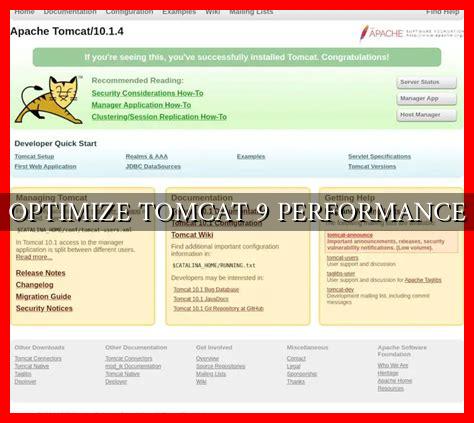-
Table of Contents
Optimize Tomcat 9 Performance
Tomcat is a popular open-source web server and servlet container that is widely used for hosting Java-based web applications. Tomcat 9 is the latest version of this software, offering improved performance and scalability. In this article, we will explore some tips and best practices to optimize Tomcat 9 performance for your web applications.
1. Upgrade to the Latest Version
One of the first steps to optimize Tomcat 9 performance is to ensure that you are using the latest version of the software. Each new release of Tomcat typically includes performance improvements, bug fixes, and security enhancements. Upgrading to the latest version can help you take advantage of these benefits and ensure that your web applications are running smoothly.
2. Configure Connection Pooling
Connection pooling is a technique used to improve performance by reusing existing database connections instead of creating new ones for each request. In Tomcat 9, you can configure connection pooling using the built-in Tomcat JDBC Connection Pool. By tuning the connection pool settings, you can optimize the performance of your web applications that rely on database access.
3. Enable Compression
Enabling compression for your web applications can help reduce the size of data transferred between the server and clients, leading to faster page load times. In Tomcat 9, you can enable compression by configuring the compression attribute in the Connector element of the server.xml file. By compressing static and dynamic content, you can improve the overall performance of your web applications.
4. Tune Thread Pool Settings
Tomcat uses a thread pool to handle incoming requests from clients. By tuning the thread pool settings, you can optimize the performance of your web applications based on the expected workload. You can adjust parameters such as the maximum number of threads, the thread idle timeout, and the queue size to ensure that Tomcat can efficiently handle incoming requests without overwhelming the server.
5. Monitor Performance Metrics
Monitoring performance metrics is essential for identifying bottlenecks and optimizing the performance of your web applications. Tomcat 9 provides built-in support for monitoring performance metrics through JMX (Java Management Extensions). By monitoring metrics such as request processing time, thread usage, and memory consumption, you can identify areas for improvement and make informed decisions to optimize performance.
6. Implement Caching
Implementing caching can help reduce the load on your server by storing frequently accessed data in memory or on disk. Tomcat 9 supports caching through features such as the Expires Filter and the Cache-Control Filter. By caching static content, database queries, or session data, you can improve the performance of your web applications and reduce response times for clients.
Summary
Optimizing Tomcat 9 performance is essential for ensuring that your web applications run smoothly and efficiently. By following the tips and best practices outlined in this article, you can improve the performance of your Tomcat server and provide a better experience for your users. Upgrading to the latest version, configuring connection pooling, enabling compression, tuning thread pool settings, monitoring performance metrics, and implementing caching are all key strategies for optimizing Tomcat 9 performance. By taking these steps, you can maximize the performance and scalability of your web applications hosted on Tomcat 9.





